Colombia Trip over IAP
01/07 (morning)
IAP, which stands for Independent Activites Period, is a program at MIT that takes place over the month of January. As the name suggests, IAP provides students with the freedom to pursue a wide variety of opportunities, from taking classes on campus to teaching in foreign countries. This IAP, I will be interning at a software company in Bogotá, Colombia called Leal. This is my first time in South America, so I am excited to soak in the culture and test my Spanish chops. My goal is to write more frequently than I did in Spain last year, which should be easy to achieve.
I arrived pretty late in the night so I haven't done much yet besides travel from the airport to the Airbnb. Some preliminary observations:
- At the airport, there will be many people asking you if you need a taxi ride, but it is advised to ignore them and take one of the official taxis.
- The air is remarkably fresh, perhaps because Bogotá is so high up. It has an elevation of 2,600 meters, a fact the locals proudly refer to in the city's slogan: 2.600 metros más cerca de las estrellas (2,600 meters closer to the stars).
01/07
As a correction, the air is only remarkably fresh when there are no cars around. The exhaust fumes make it hard - almost painful - to breathe otherwise. Crossing traffic in Bogotá also poses a threat to one's life, as a lot of crosswalks don't have traffic signals.
Today was my first day at Leal. Unlike tech companies in the States, the office does not have unlimited snacks and drinks. However, the office staff are very nice, and will bring water to your desk.
01/08
One great thing about Bogotá is the prevalence of electric scooters. There is a dedicated lane for scooters that runs through the city, which makes them very convenient for commuting to and from work. I always thought electric scooters were a fad, but Bogotá has convinced me otherwise.
Some of you may be curious about what it's like to write code in a country where English is not the primary language. As you might expect, variable names are sometimes English, but seem to mostly be Spanish. Common terminology is still carried over from English, but lose some of their meaning. For example, it's difficult to understand why APIs are called APIs if you come from a Spanish-speaking background because the acronym (Application Programming Interface) doesn't work in Spanish. Fun fact: APIs are pronounced AH-peas here.
Surprisingly, I have also yet to try authentic Colombian food. Burgers, pizza, tacos, stir-fry, sushi, and poke bowls seem to be pretty popular here.
01/09
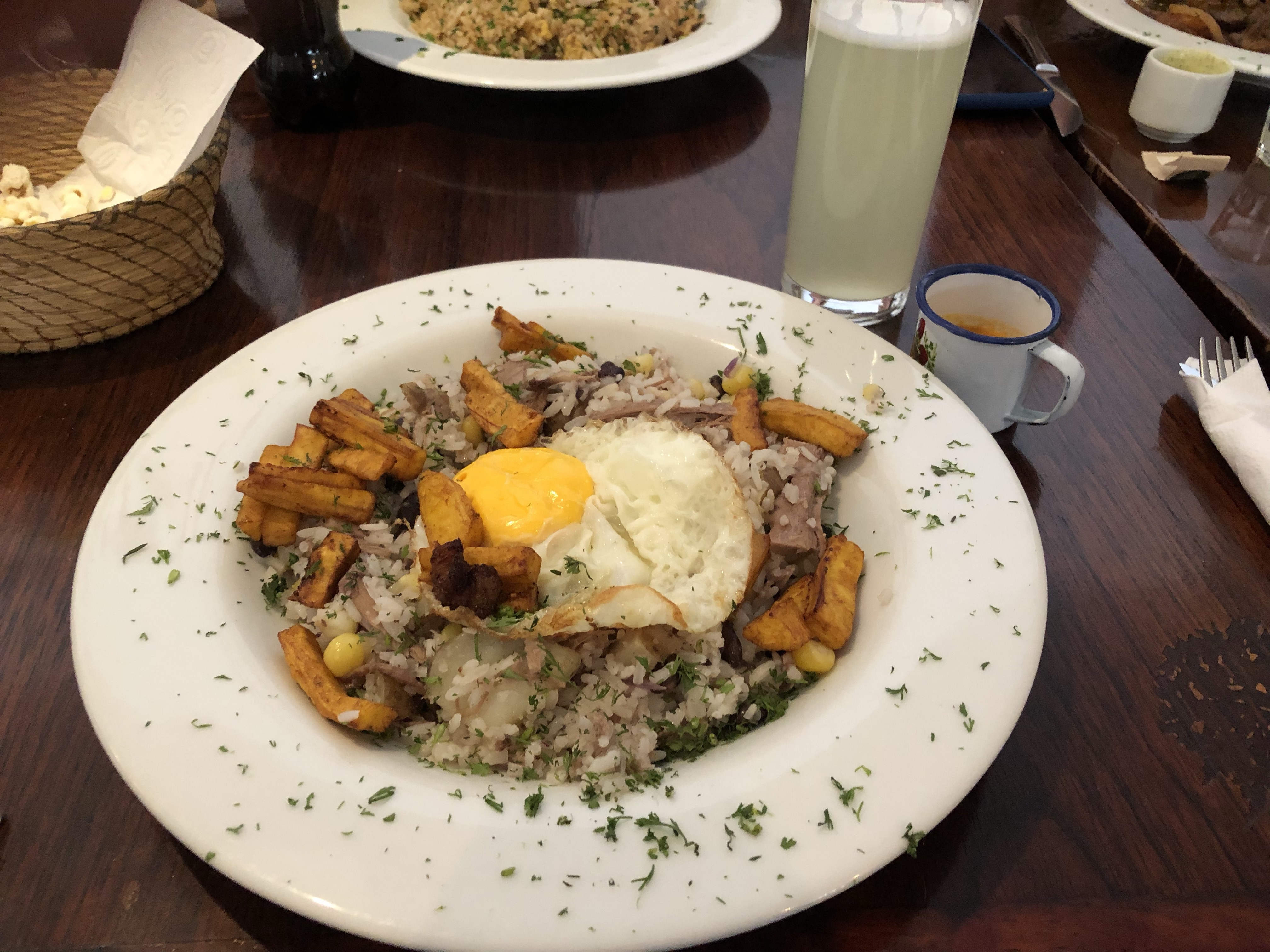
My first Colombian dish! Colombian fried rice with a side of lemonade. The fried rice contained an egg, potatoes, rather large kernels of corn, beans, and platain fries (my favorite part), as well as a side of salsa. We were also given baskets of popcorn as a complimentary appetizer (seen in the top left).
01/10

Had a chance to try more Colombian food today. They are a big fan of plantains. Here is a burger with fried plantains instead of buns.
01/11
This morning, I had a chance to climb up Monserrate, a mountain on the Eastern border of Bogotá. Monserrate is a popular tourist destination because of the gorgeous views of the city at the peak, but also an important religious location because the mountain range resembles the Fallen Lord (not present in the picture). The trek up the mountain is quite tiring though. Due to Bogotá's high altitude, there's less oxygen in the air.
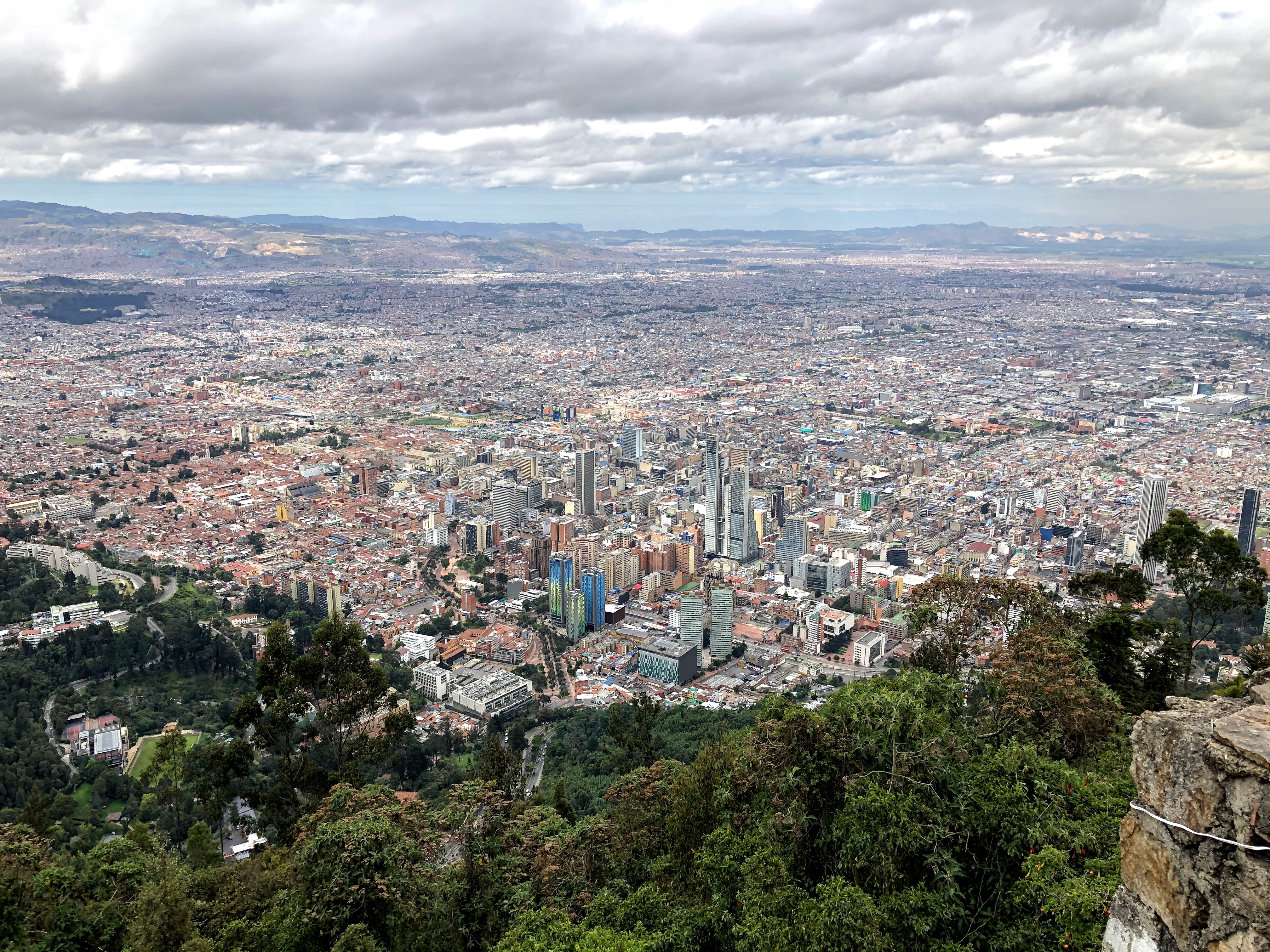
While I was at the peak, a Bogotá resident approached me because I don't look like I come from Colombia. We talked for a bit - it turns out he's an online Spanish teacher. I ended up spending the afternoon with him and his family at the Botero Museum. Fernando Botero is a Colombian artist who is famous for painting and sculpting obese people and objects.
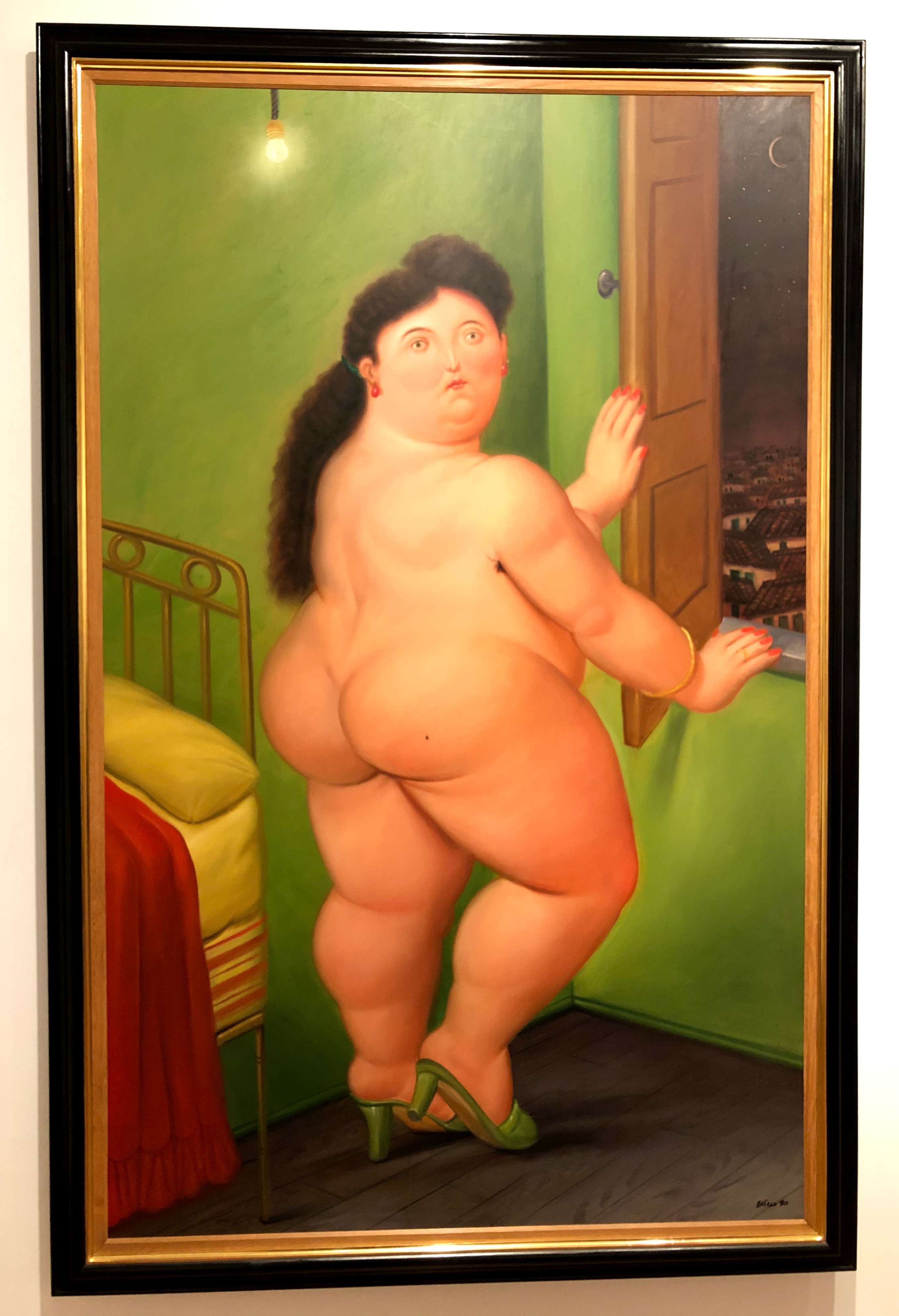
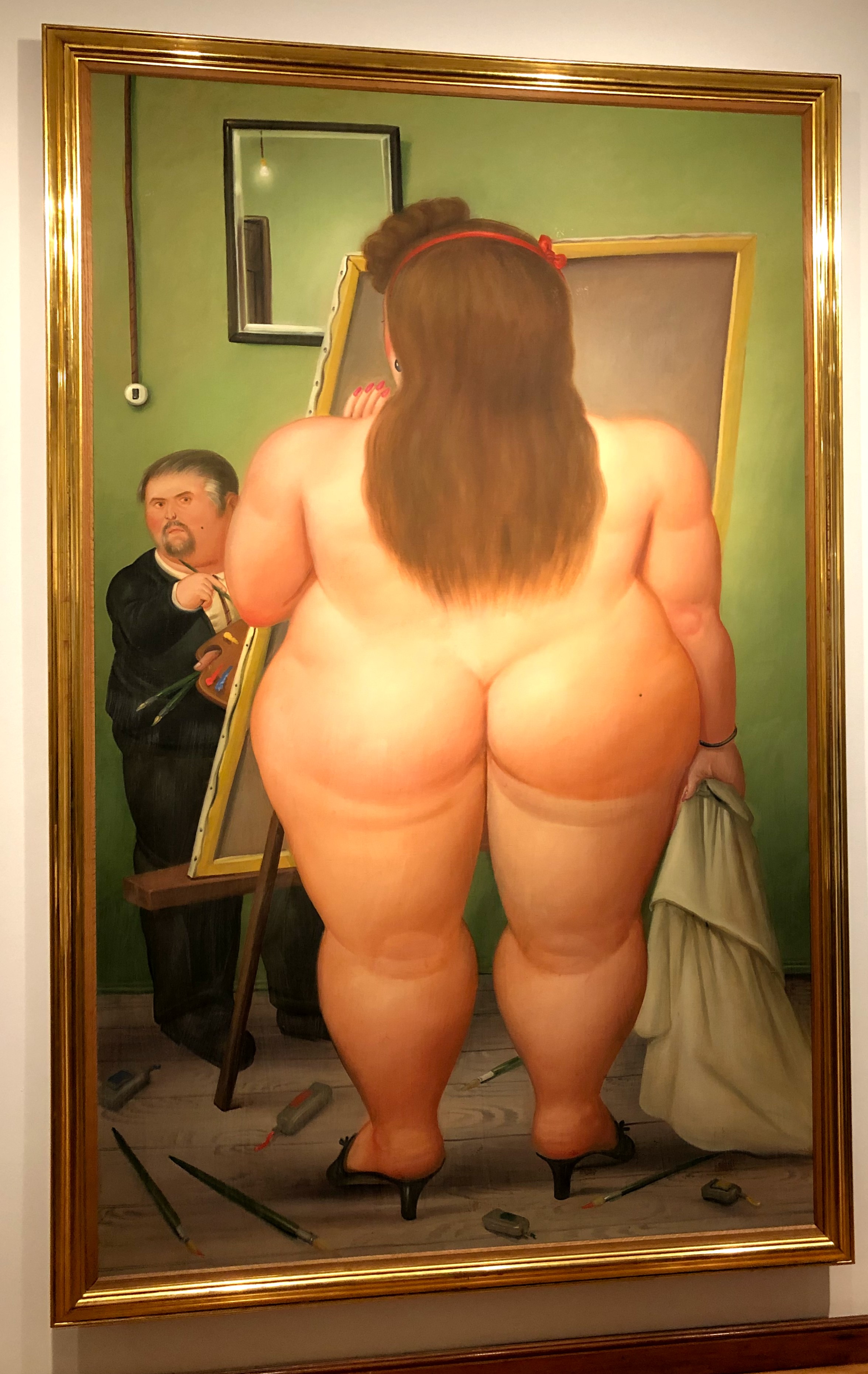
Afterwards, we went up the Colpatria Tower, which used to be the tallest building in Bogotá. Our timing was perfect and we got to catch the sunset. The picture on the left is of Monserrate.

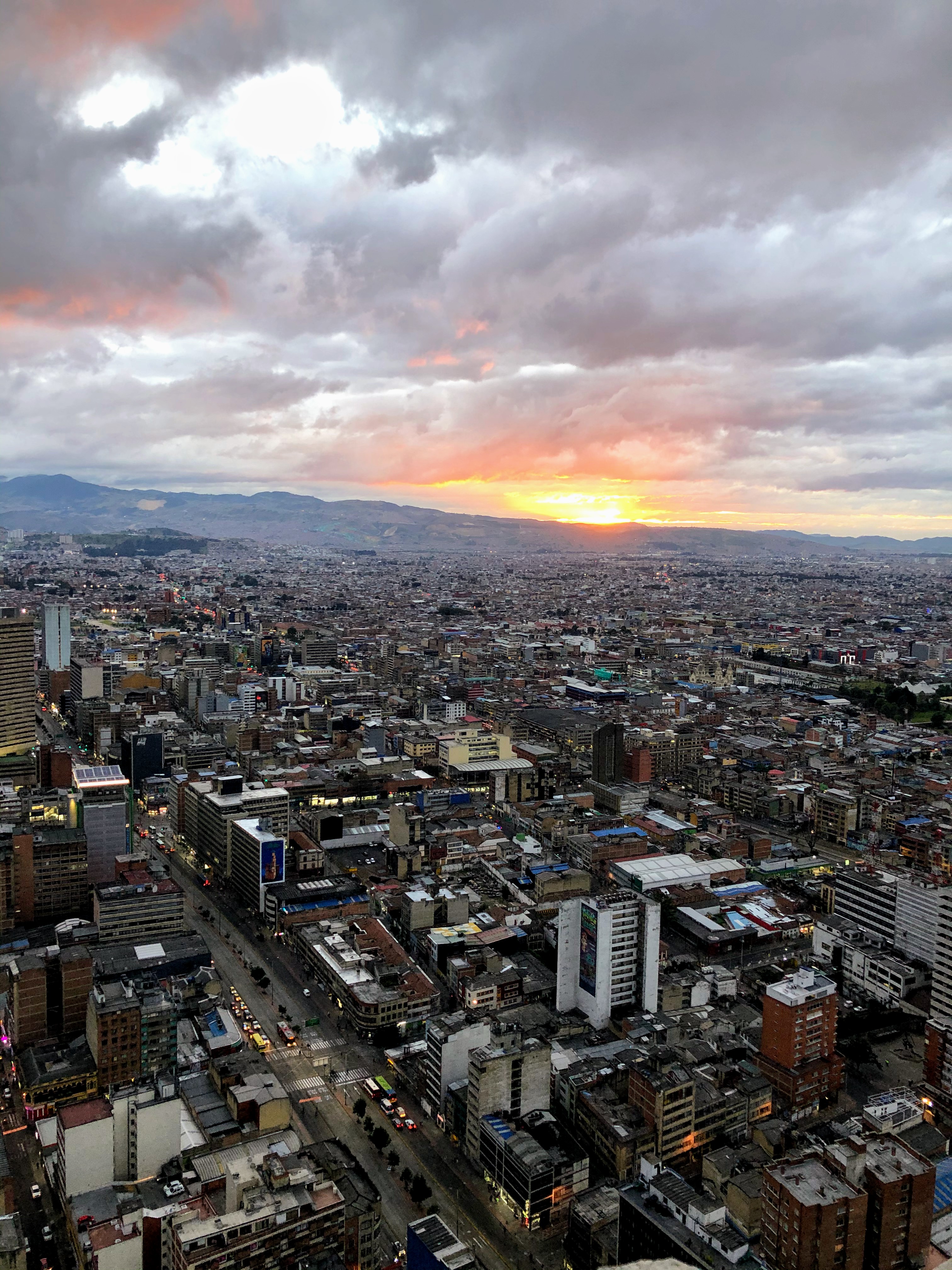
Thanks Daniel!

01/12
I woke up early again today to explore the Usaquén market. Every Sunday, vendors set up shop at this "flea market" to sell artisanal goods like jewelry, art, and cloth. Every Sunday, the city also closes down some public roads for people to ride their bicycles. I was impressed by this city-wide health movement.
Afterwards, I visited the Gold Museum. As you can guess, there were a lot of gold artifacts. I was kind of underwhelmed - there's only so much gold you can see before it gets repetitive. Since I was in the Candelaria neighborhood, I paid a visit to a famous restaurant called La Puerta Falsa. I had a tamale to eat and an Aguapanela to drink. The tamale was very good, and the Aguapanela was very interesting. It was a bowl of hot water with sugar dissolved into it. It also came with bread and cheese. Apparently, you're supposed to put the cheese into the drink while it's hot so that the cheese melts, but I couldn't bring myself to do so. Colombians also drink their hot chocolate with cheese!
Unfortunately I don't have any pictures because I was pick-pocketed this afternoon, and hence no longer have my phone :'(. I had done my research, so I knew the basics: don't stare at your phone in public, don't use your phone on the bus, etc. But this was some next level pick-pocketing.
I was walking on the street, minding my own business, when suddenly I felt a splash of fluid on the side of my face and back of my head. As I turned around, astonished, a women gestured towards my head and said something in Spanish that I couldn't make out. I was slightly panicking because I thought a bird had pooped on me (it turns out the fluid was just water, hopefully). By the time I turned back around, my phone had been snatched out of my pocket. I'm guessing the woman, the theif, and whoever sprayed my head with water were all in kahoots.
This is my first time getting pick-pocketed. In the past, I always wondered how victims of theft couldn't feel someone's hand against their leg - shouldn't it be pretty noticeable? Now I realize that's not the case. In the heat of the moment, it's very hard to be aware of one's surroundings.
Colombians have a saying "dar papaya" (to give papaya) which means to give someone the opportunity to take advantage of you. In their culture, if you dar papaya, then it's your fault for getting robbed. I might have given the papaya, but someone else watered it first.
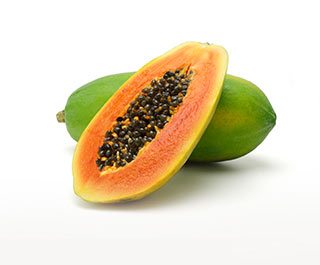
1/19
I spent the weekend in the Colombian town of Salento, which is around two hours from Bogotá (1 hour flight + 1 hour bus ride). I arrived the first day at around noon-time. After a large lunch consisting of patacón (a big fried plantain) and bandeja paisa (a classic Salento plate)...
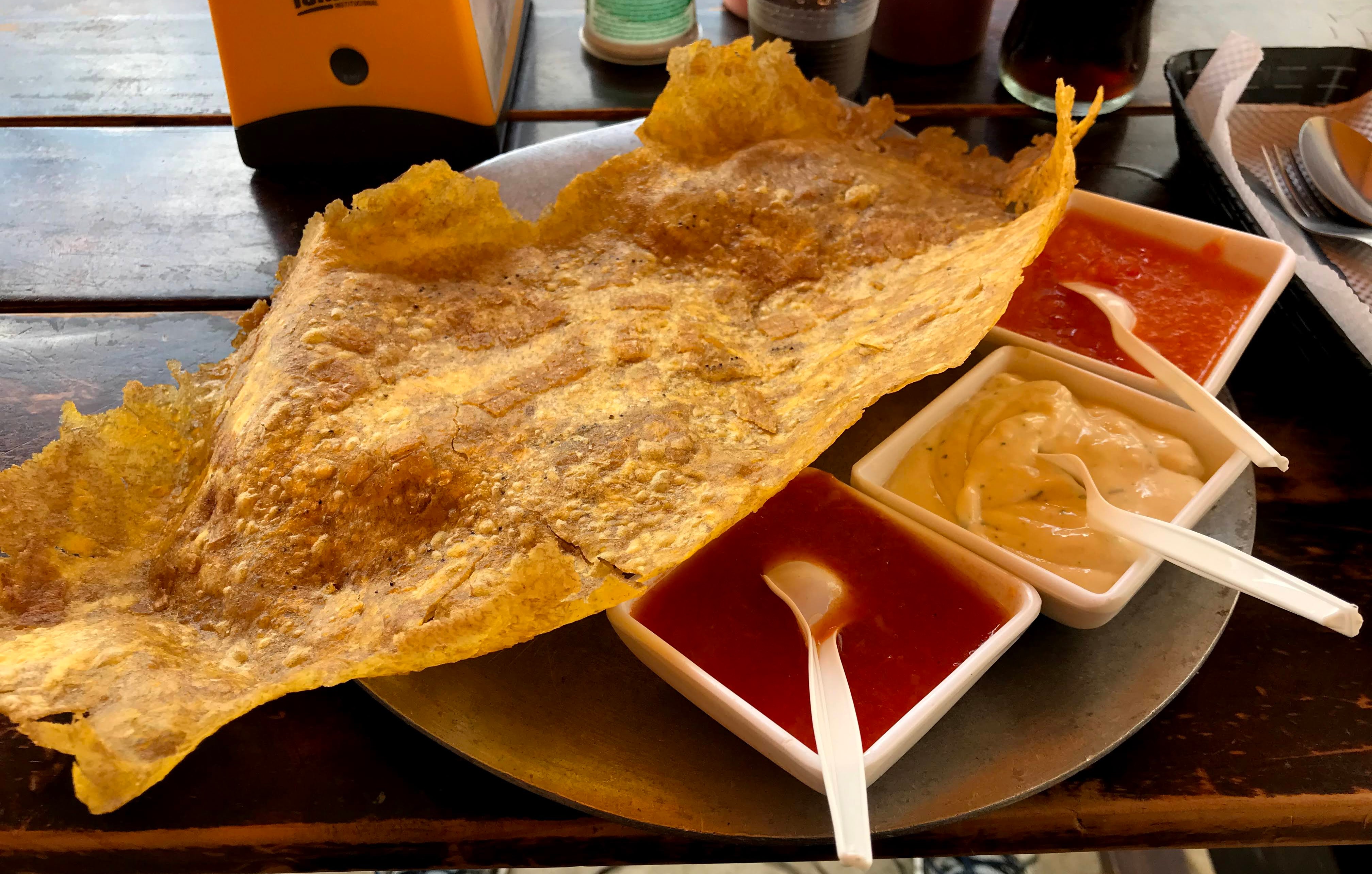
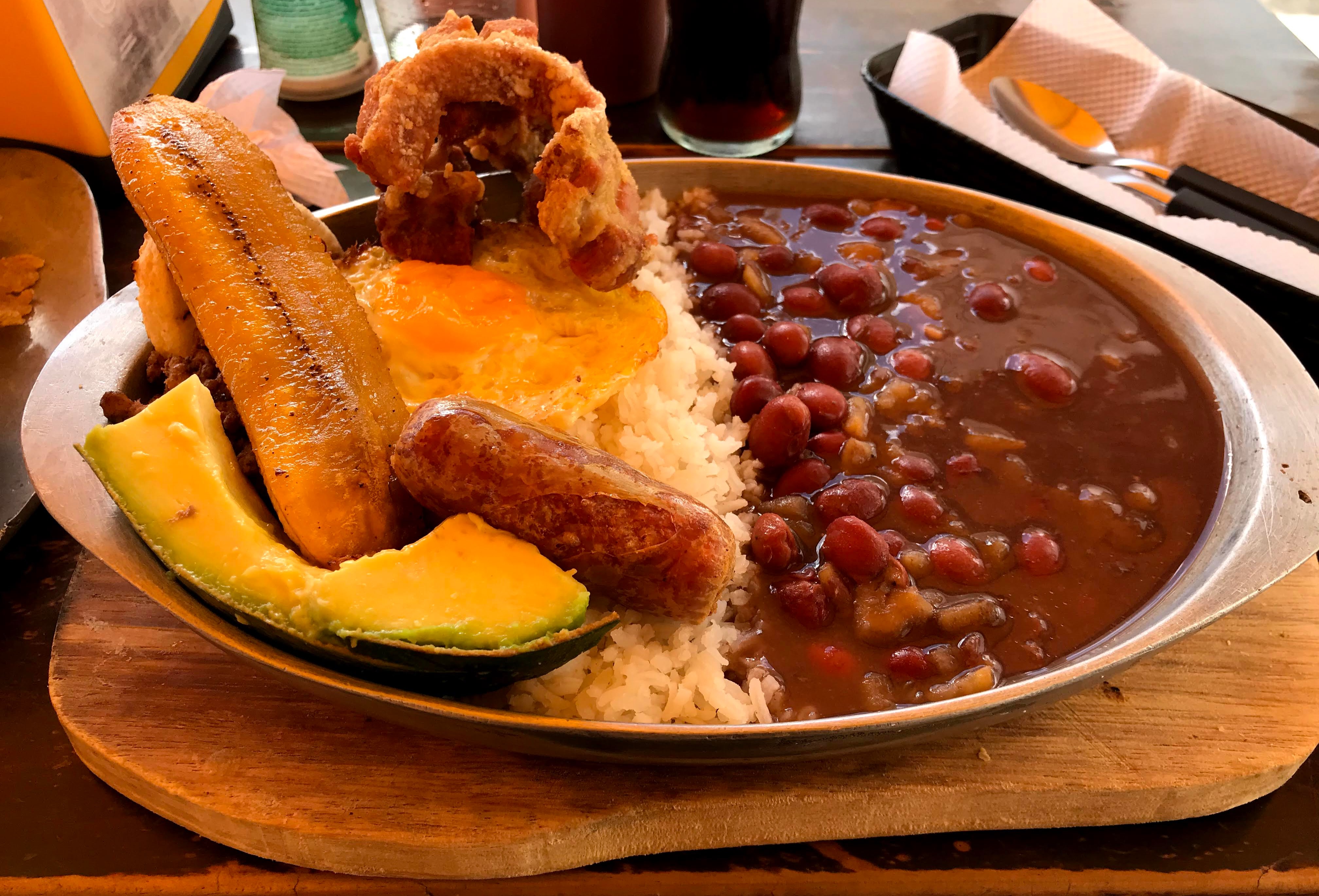
...I went on a tour of a nearby coffee farm. Salento is part of Colombia's "Coffee Triangle", so theoretically the coffee should have tasted really good, but because I don't like coffee, it tasted even worse than usual (in addition to being bitter, it was also sour). However, I still really enjoyed the experience because I learned a lot about coffee. For example, there are two tiers of coffee beans produced at the farm. All the top-tier beans get exported, and the bottom-tier ones stay in the country to be consumed by Colombians. Sad. Also, coffee "cherries" usually have two beans inside, like so:

But sometimes the two beans will fuse into one to become a super bean. These super beans, also known as Peaberries, supposedly produce extra-potent coffee, and therefore are more expensive.
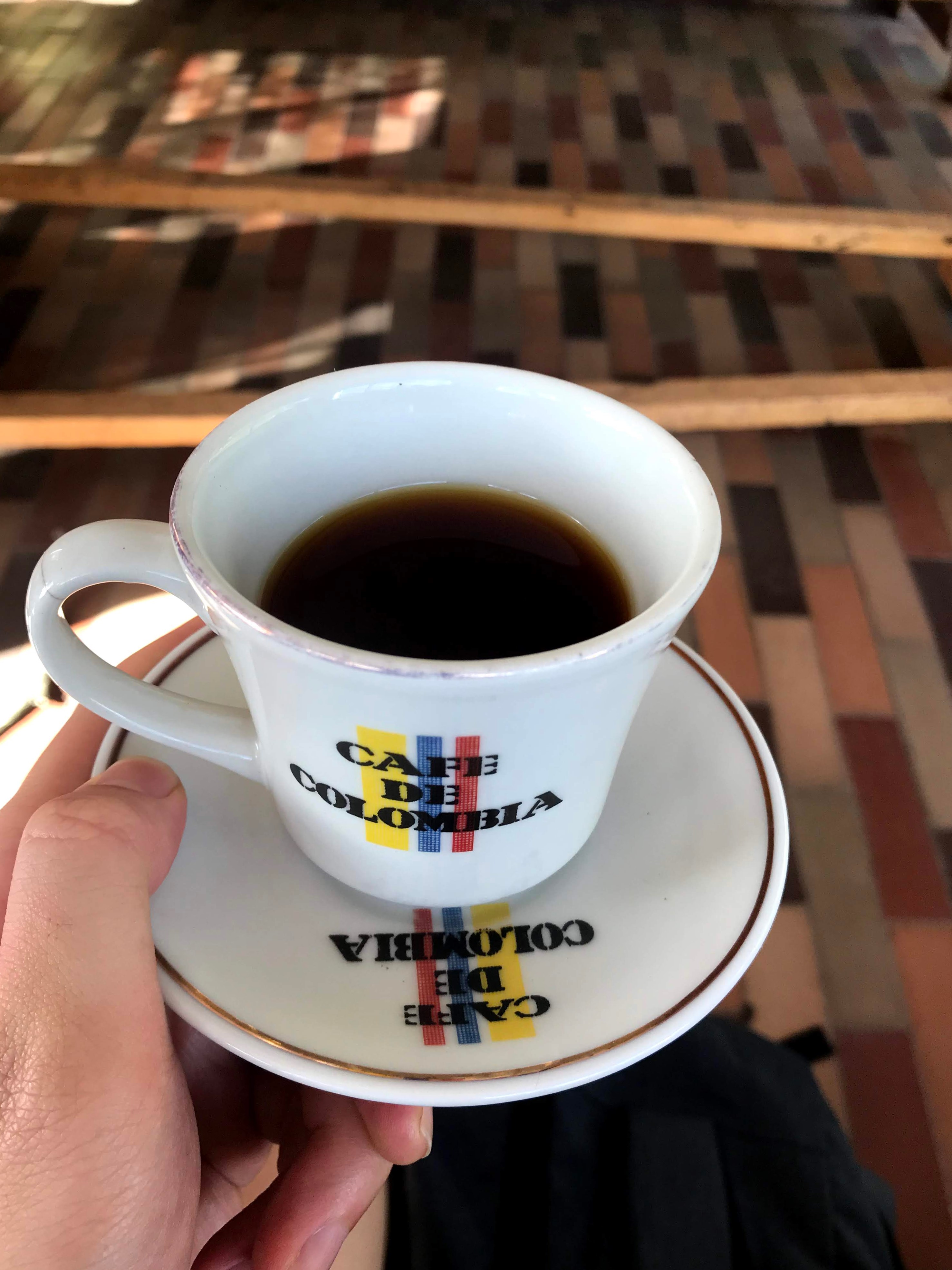
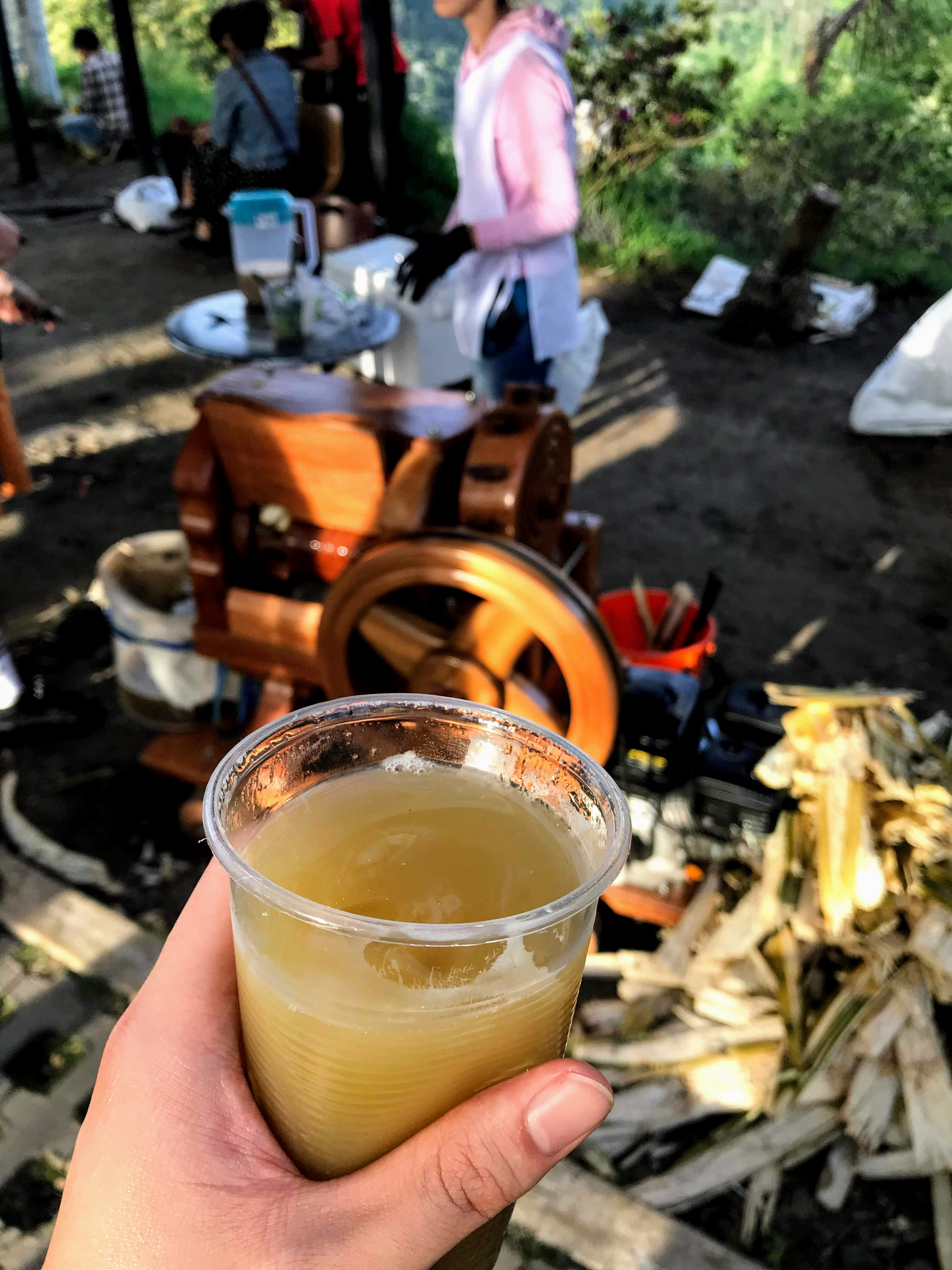
The picture on the right is not coffee, but rather fresh-pressed sugarcane juice. For dinner, I had trucha (trout), another popular dish in Salento, before heading to my hostel Yambolombia.

This was my first time staying at a hostel. Overall, I'd say the experience was not bad. I met an interesting lady from Spain who practices permaculture. She told me that shampoo is unnecessary for washing hair; in fact, pure water produces the best results. There was also a horse at the hostel. It was staring into our room when I woke up.
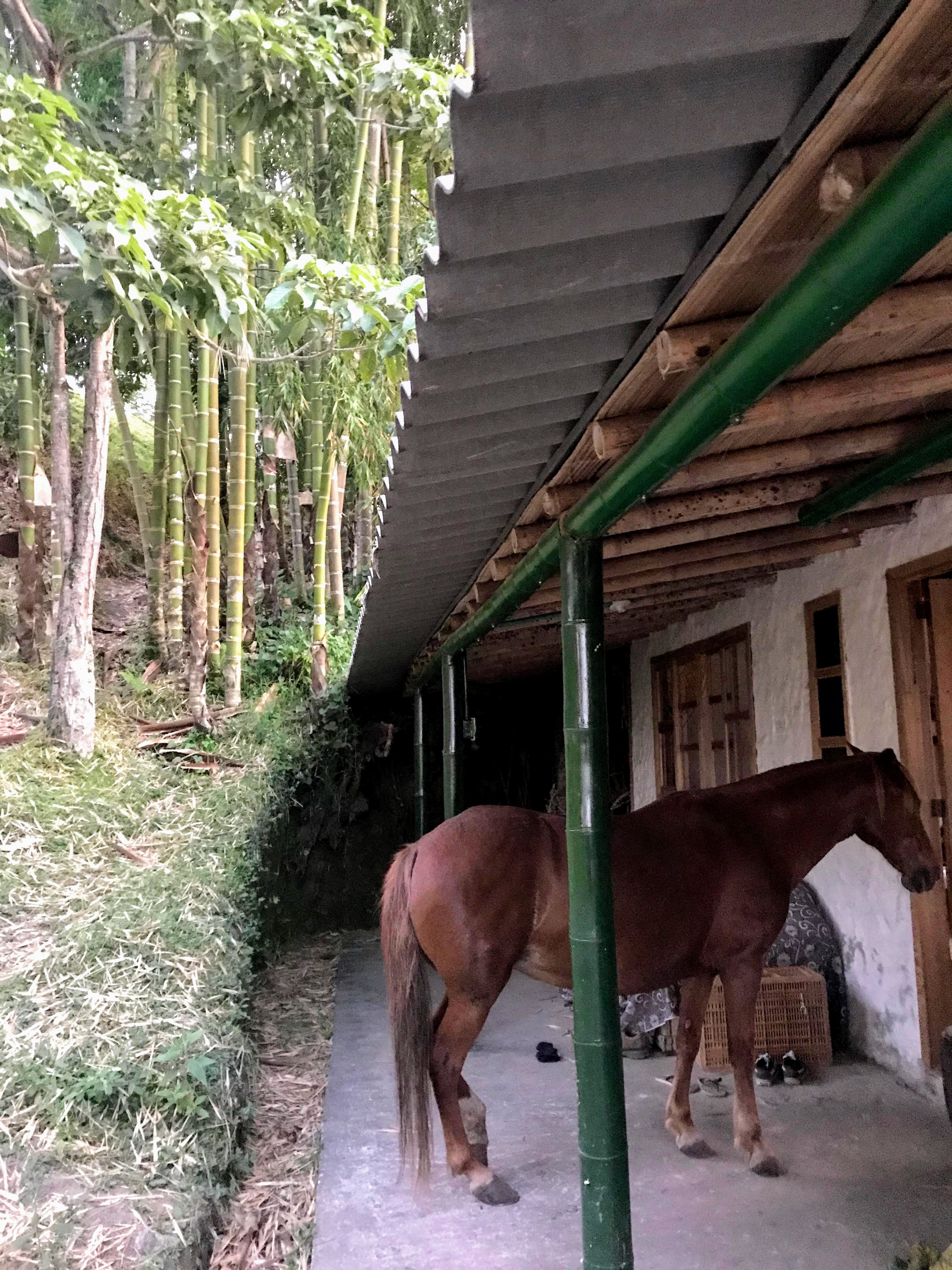
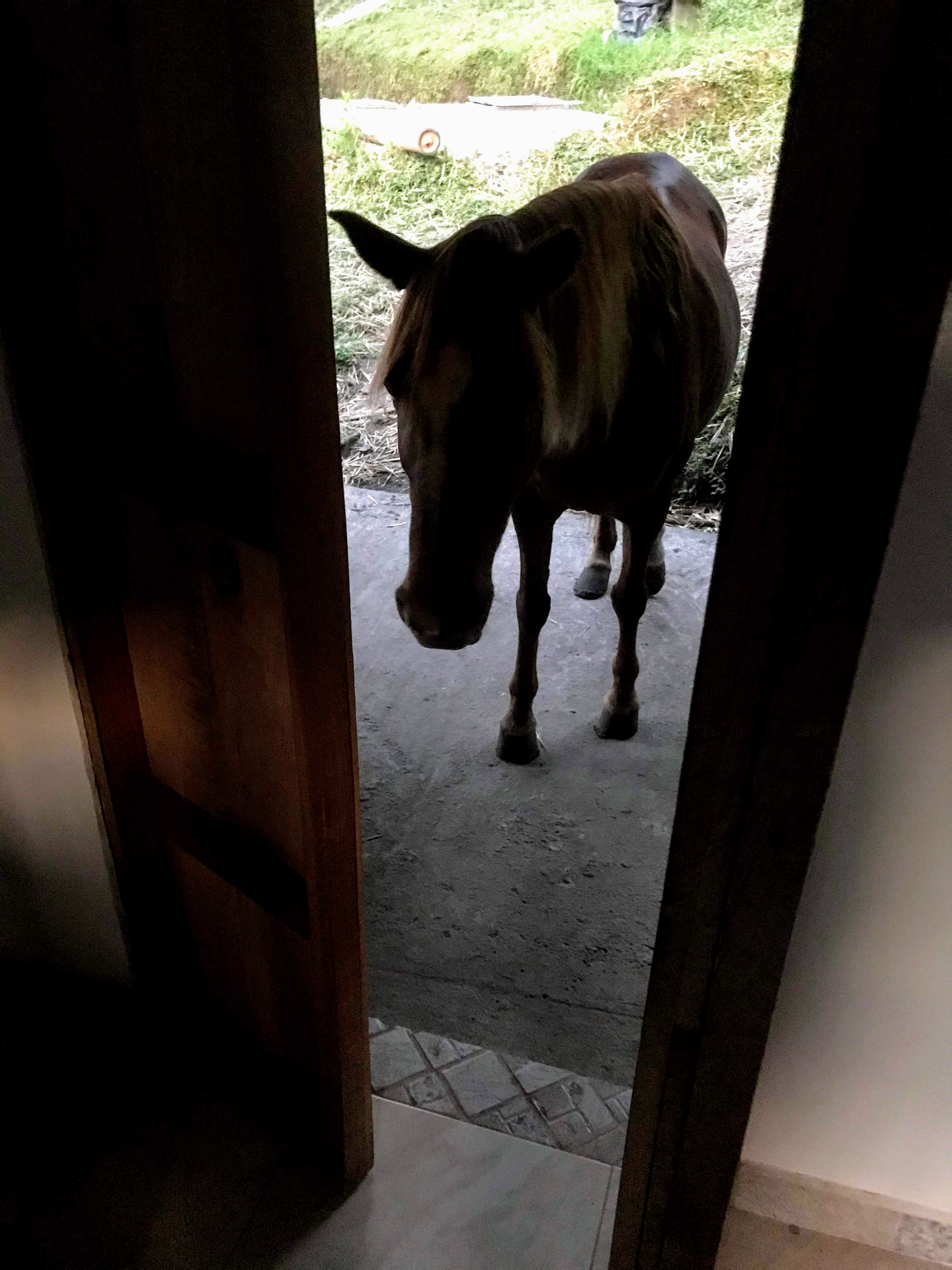
The next day, I went on a five hour hike at the Valle de Cocora. The location is famous for the Qundío Wax Palms, the national tree of Colombia. They are very tall!

I also met some cows.
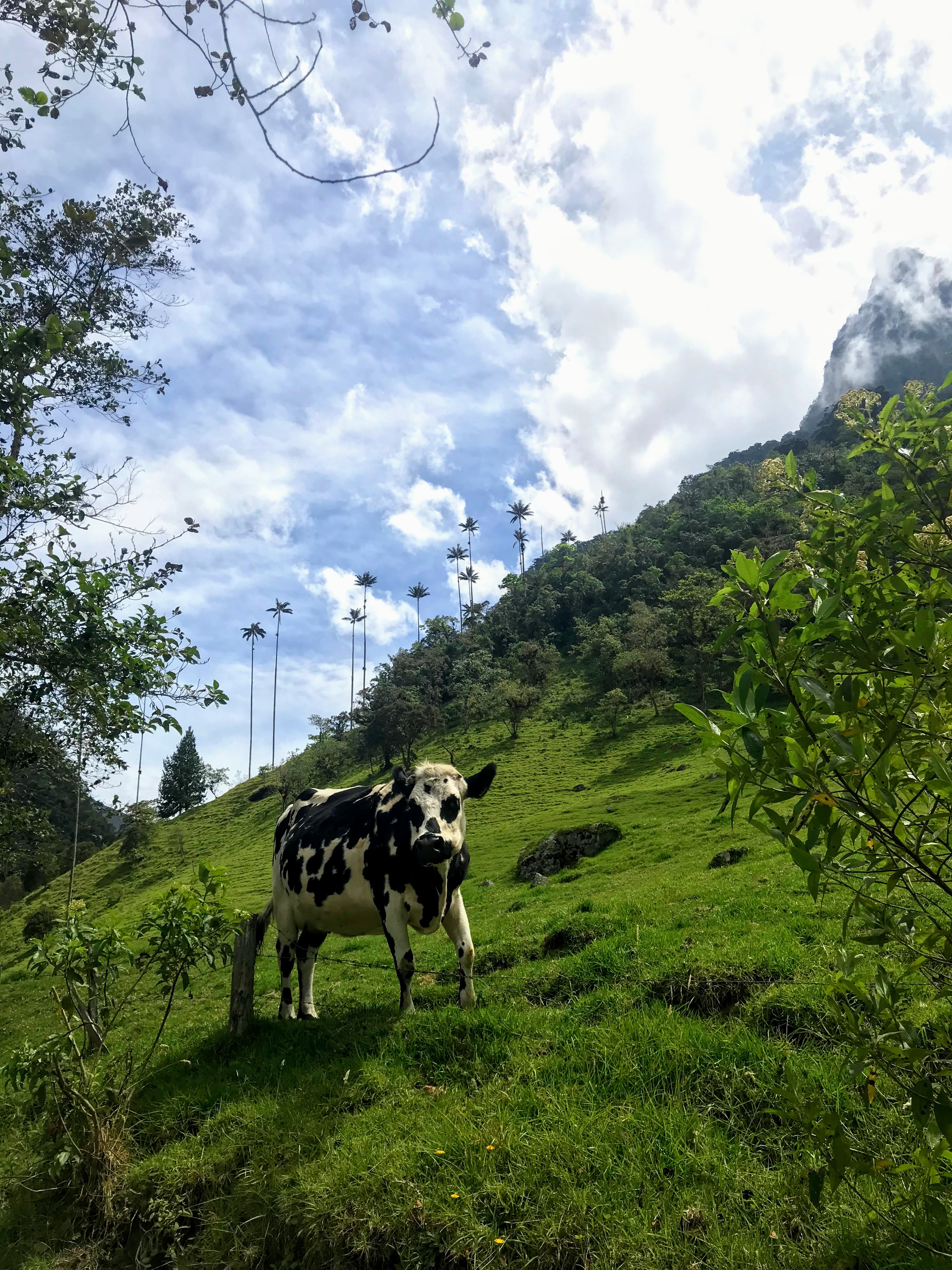
Finally, one of the coolest things about Salento is the public transportation. Instead of taxis or buses, they have jeeps that drive people around. These jeeps, known as Willys, can fit 10 people because three lucky people have to stand on the back ledge and hold on to the railing. I especially recommend being one of those three people on the way to or from the Valle de Cocora, because you'll get excellent views of the mountains as well as a lot of fresh air.
01/27
I spent this weekend at Cartagena, a coastal town at the northern tip of Colombia. Cartagena is a popular cruise destination, so I saw a lot of American tourists on the streets. Gabriel Garcia Marquez, the author of 100 Years of Solitude, also grew up in this town.
My first day, I walked around the Walled City. The Walled City is a part of the city that is enclosed by a thick wall. Unfortunately I don't know much about its history because I was suspicious of anyone who approached me to try to give me a tour.
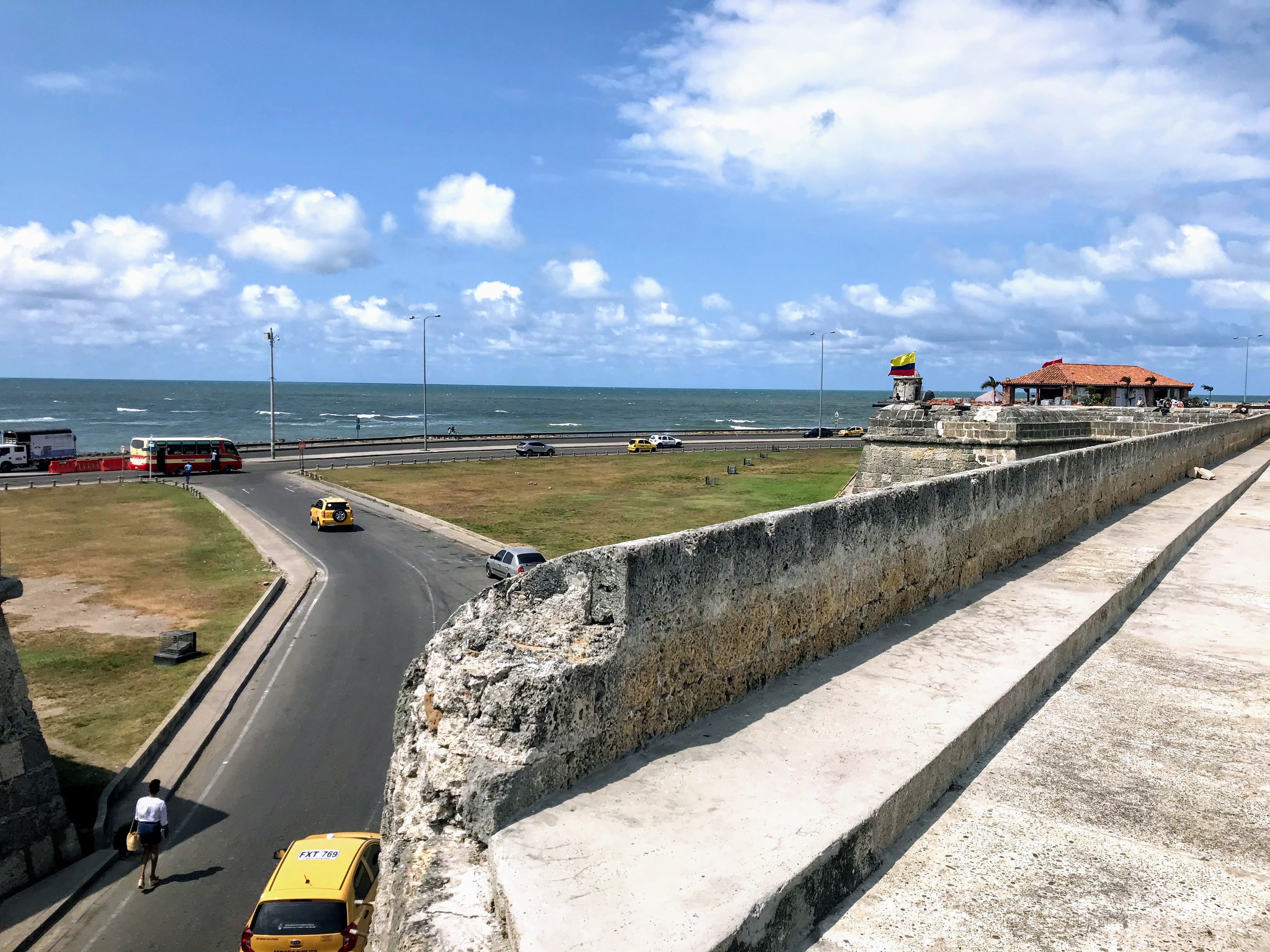
The Walled City is designated as a UNESCO World Heritage Site, so a lot of the buildings on the interior were built a long time ago. I really enjoyed the colors of the architecture.


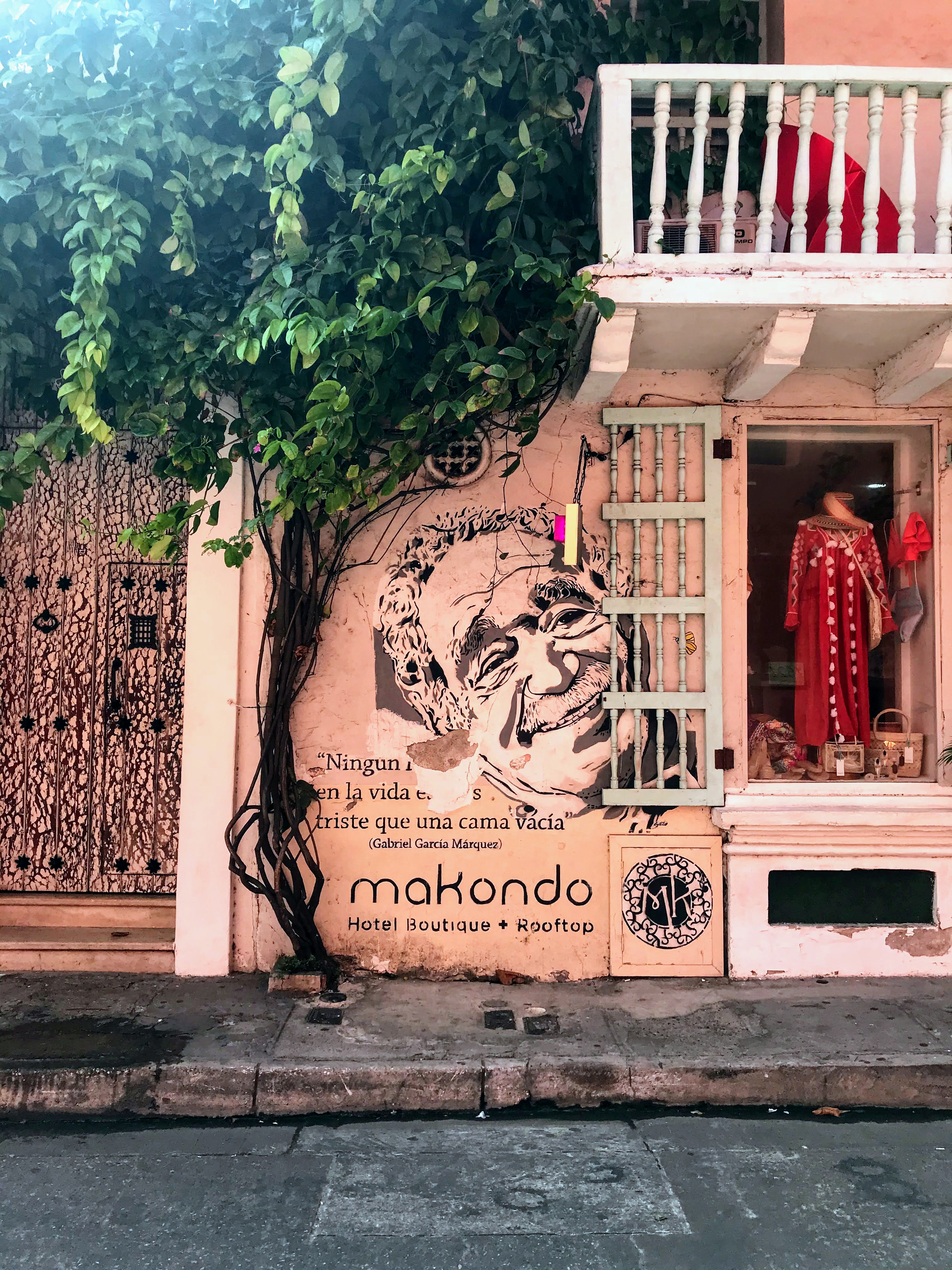

For lunch, I ate at a widely recommended restaurant called La Cevicheria. The seafood was very fresh, but every time I took a bite my lips stang cause the lemon juice was so potent.


In the afternoon, I visited the Castillo de San Felipe.

At night, I went back to the Walled City. It really comes alive with lights and street performances.
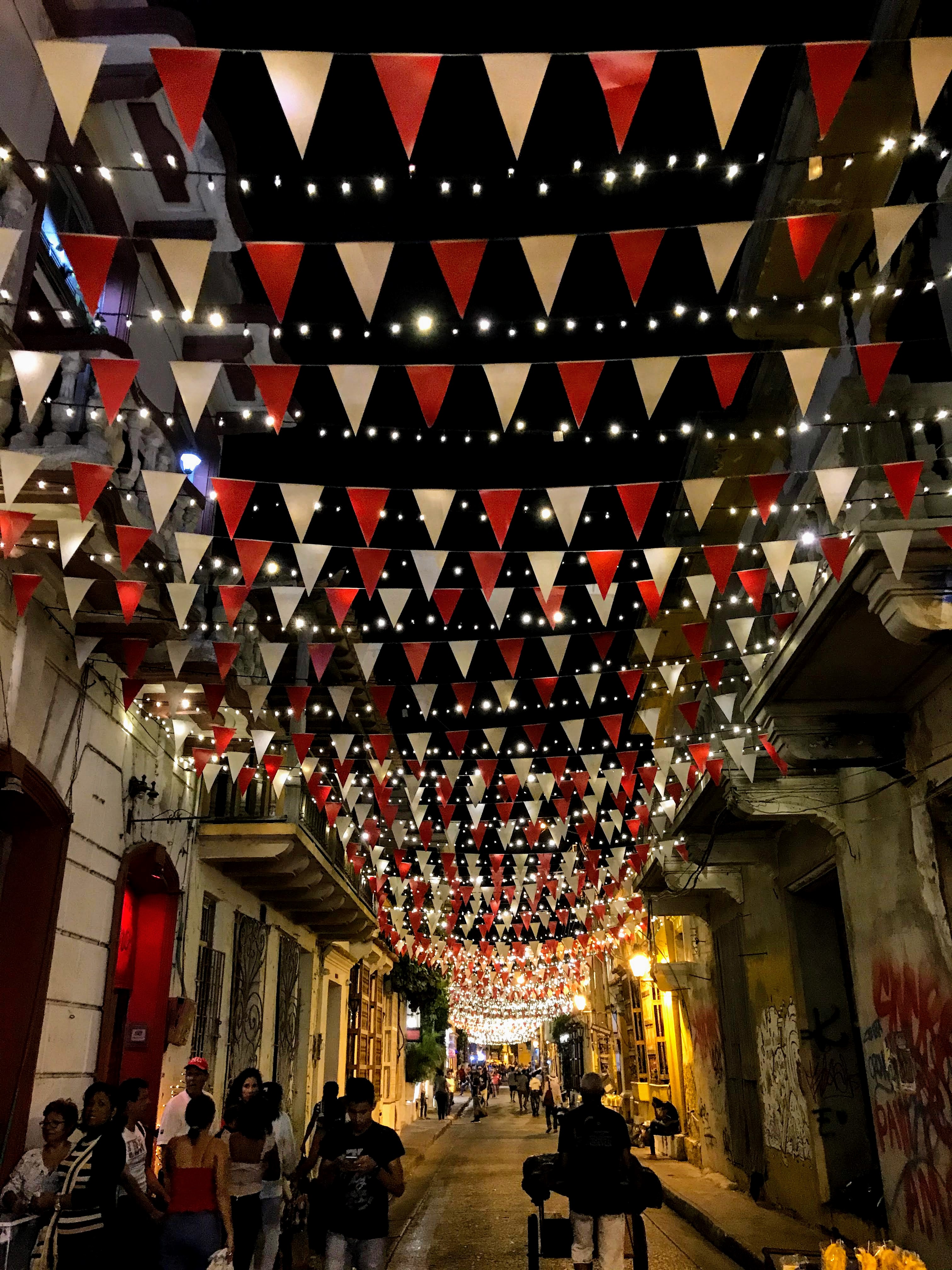
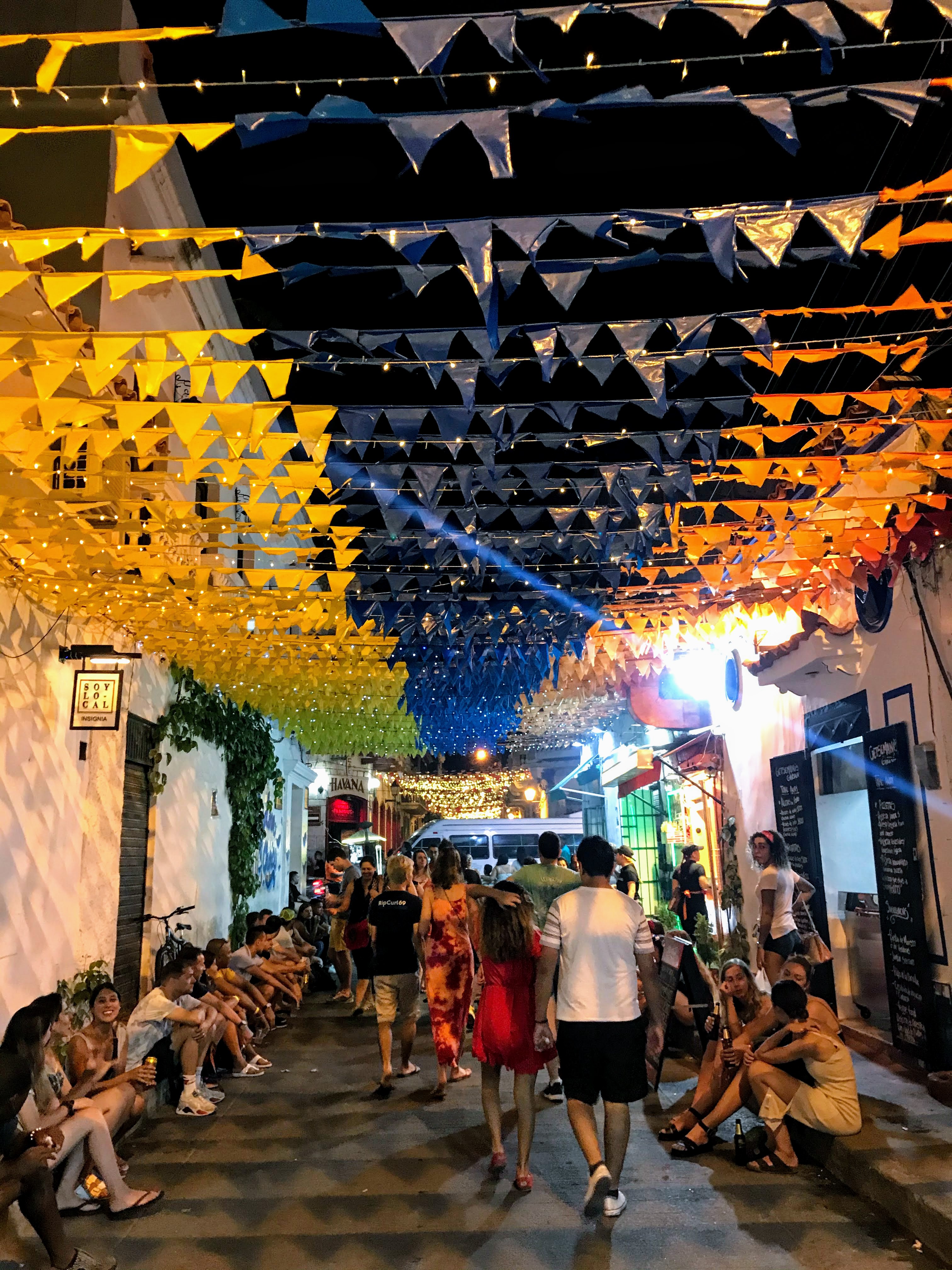
On the second day, I visited La Playa Blanca, a beach around an hour south of Cartagena. It was probably one of the most beautiful beaches I've been to.
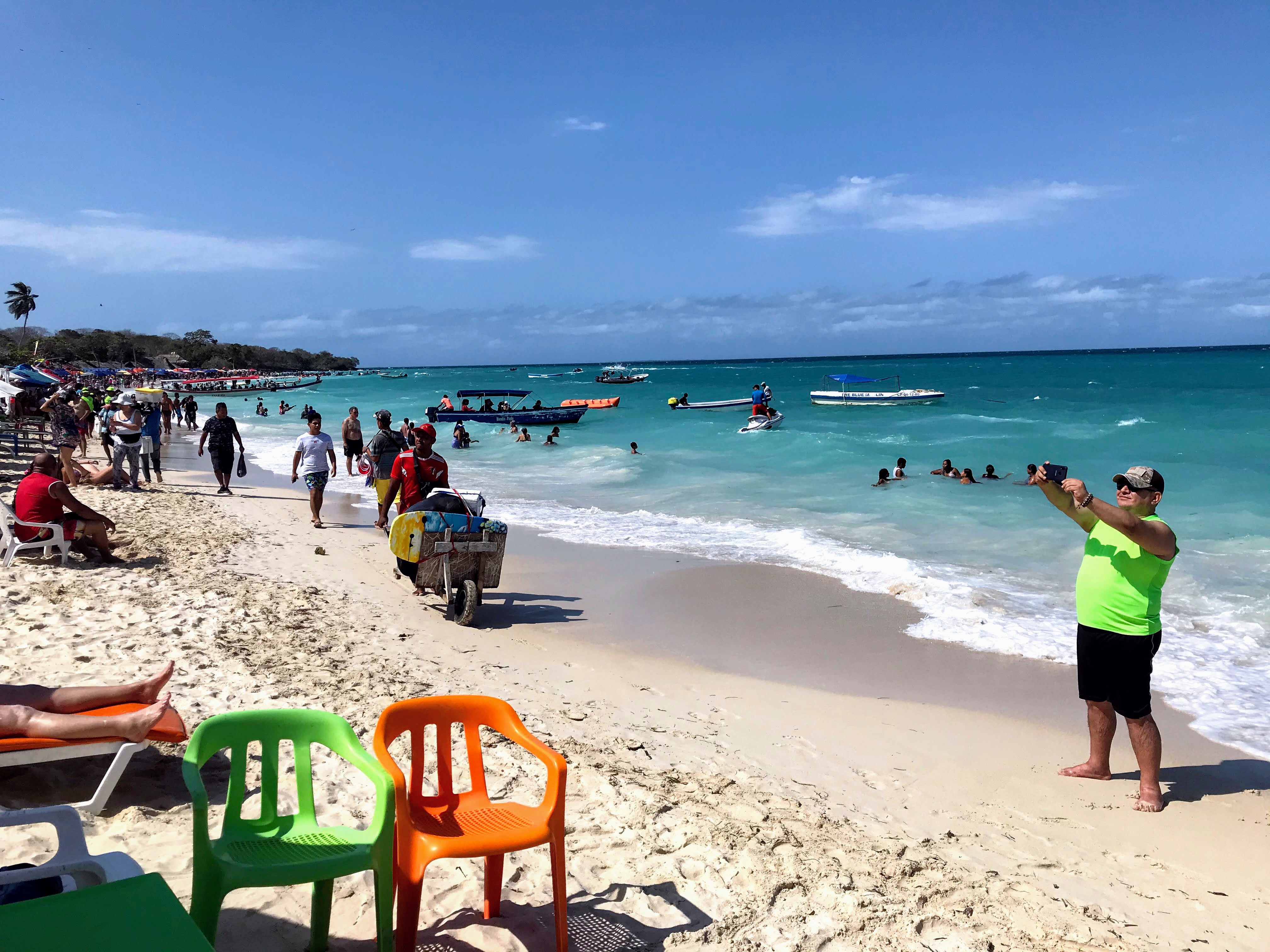
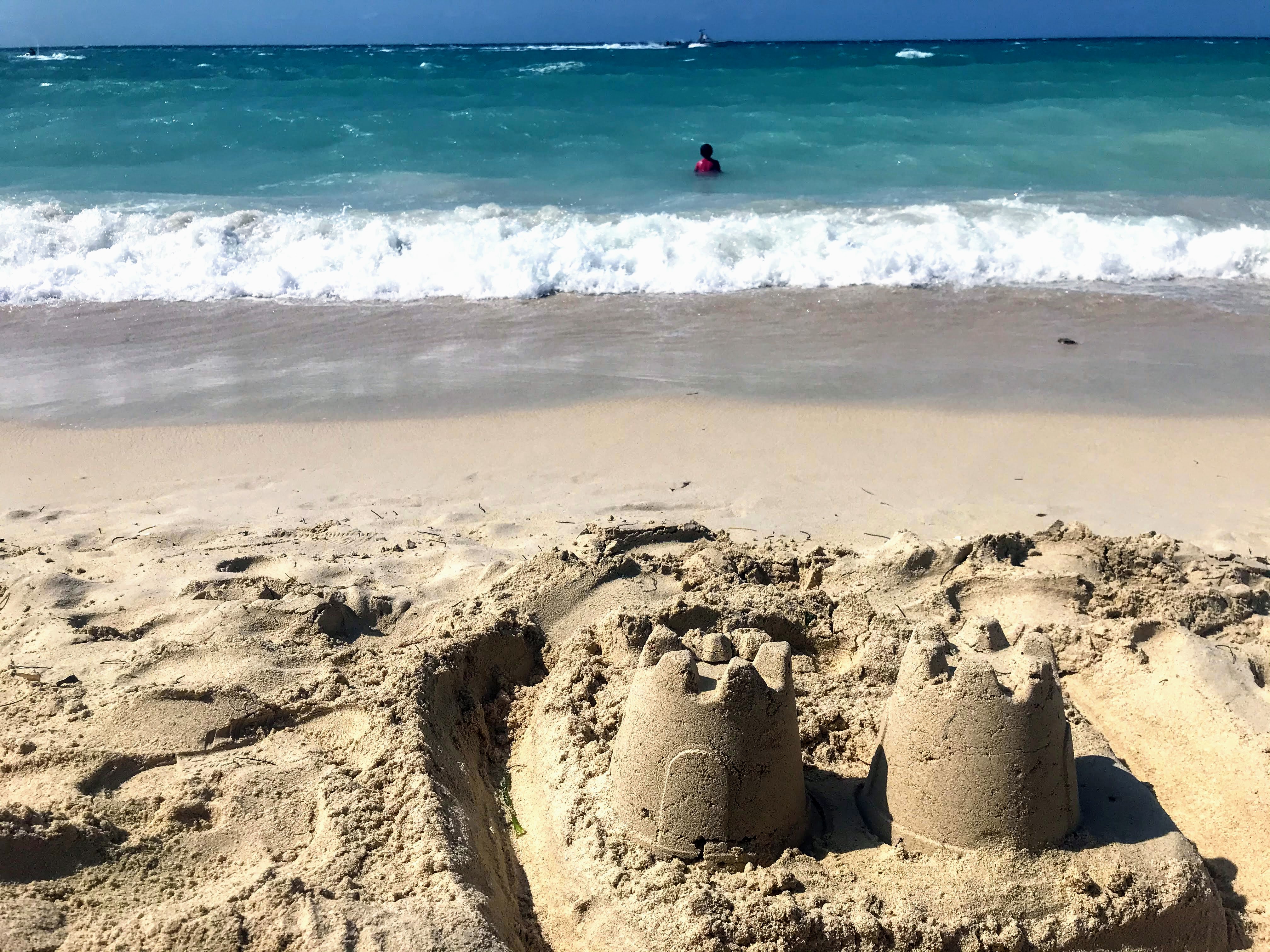
Unfortunately I think I got scammed again. After I got off the bus, a local approached me and offered to take me to my hostel's restaurant on the beach. It was pretty suspicious because I was led away from the other people in the group, and the place I was brought had no mention of my hostel's name anywhere. However, it was difficult for me to walk away, since he had already established that we were "amigos". He tried to offer me a lot of things for purchase but I always asked for the price beforehand so I didn't end up spending too much. I was just charged with an unexpected service fee. And I ended up getting a spot on the beach with fewer people, so I guess it wasn't all that bad.
After I got back from the beach, I still had a few hours to kill before my flight, so I hung out at La Serrezuela, a high-end shopping mall that originally was a bull-fighting ring. There was a gorgeous light show in the center of the mall around sunset.

And that concludes my Cartagena trip! The city gifted me a few ant bites and a huge sunburn, but also good food and great weather.
02/01
Today is my last day in Colombia. Overall, I really enjoyed my time here. I think that one month was a good amount of time to spend in the country. Two days feels suprisingly long when you're exploring a new city, so I think I was able to see a lot of Bogotá, Salento, and Cartagena on each of the weekends. And I had enough weekdays to accomplish a meaningful amount at work. I'm excited to be going back home though because traveling is tiring (and stressful when you're alone). When I was in Salento, I met an German/Australian couple that was on an 8-month motorbiking trip across South America. That blew my mind, if I were in their shoes I imagine after the first week I'd want to go back home to take a break. But then again, vacationing is probably more relaxing if you have a couple months to do it. From what I heard, in Europe it's part of the culture to spend at least one month of the year on vacation. Perhaps America's workaholic culture makes planning a trip feel like work in itself.
In my travels across Colombia, I noticed that there are a lot of tourists from Germany and Canada, but not many from America. (Out of the 11 people in my coffee tour group in Salento, six were from Germany and 4 were from Canada. I broke the streak.) Daniel, the friend I met on top of the mountain, guessed that Americans are still very scared of Colombia because of shows like Narcos. I think that's kind of unfortunate because the food and nature in Colombia are pretty great.
There were even fewer Asians than Americans. Countless times, people on the street would try to guess my ethnicity, or shout "chino!" to get my attention to try to sell me something. I got so used to being the only Asian that it would feel out of place to see another Asian. I made a couple memes (pronounced meh-mehs here) to reflect my experience.
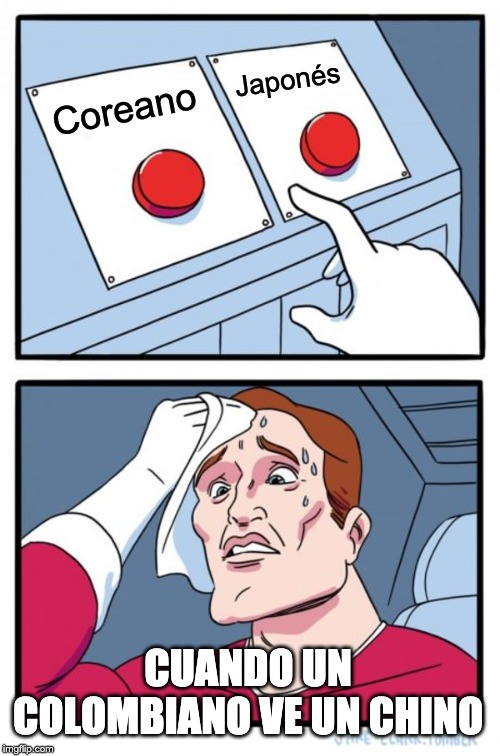
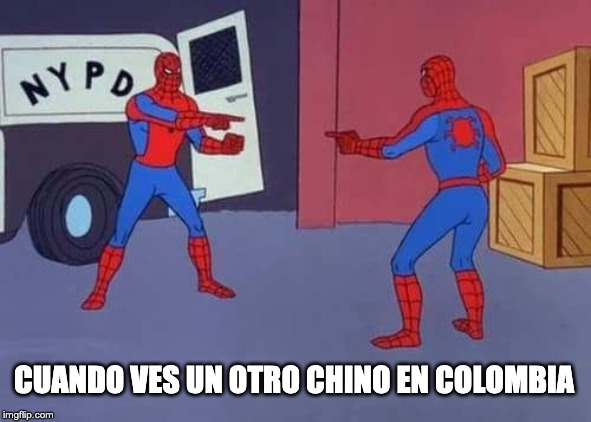
I'm not sure if what I experienced qualifies as racism, since I think people were mostly just curious and did not have any malicious intentions.
Changing topics, yesterday was also the last day of Uber's existence in Colombia, so I think I came at a pretty opportune time. There are still other rideshare apps like DiDi, but I imagine those will soon disappear as well. Last year when I was in Madrid, the taxi union was actively protesting Uber too. If you're a taxi driver then Uber is bad news, but for the rest of us I think Uber and other rideshare apps make life much better. I guess the Colombian taxi union was strong enough to lobby their case. It's interesting to note that that ridesharing apps were always illegal in Colombia, it's just that now the government is actually doing something about them.
Earlier tonight, I took a DiDi to the airport. Anti-rideshare security is especially stringent at the airport because of the dedicated taxi pick-up zones. My DiDi driver seemed especially stressed. She told me to say that we were friends if anyone asked, and made sure we knew each other's names. I think she also told me to get out of the car quickly once we arrived, but I'm not certain since my Spanish isn't that good. Luckily everything went smoothly.
I'm grateful to Leal for giving me the opportunity to work and travel in Colombia, and to my coworkers and Daniel for making my time here quite enjoyable. Hopefully I'll have a chance to come back in the future!